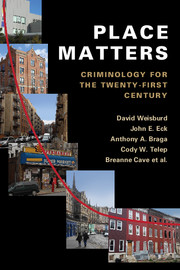Book contents
- Frontmatter
- Contents
- List of figures
- List of tables
- List of contributors
- Preface
- 1 Crime Places within Criminological Thought
- 2 The Concentration of Crime at Place
- 3 Theories of Crime and Place
- 4 The Importance of Place in Mainstream Criminology and Related Fields: Influences and Lessons to be Learned
- 5 Methods of Place-Based Research
- 6 Reducing Crime at High-Crime Places: Practice and Evidence
- 7 Crime Places in the Criminological Imagination
- Notes
- References
- Index
6 - Reducing Crime at High-Crime Places: Practice and Evidence
Published online by Cambridge University Press: 05 April 2016
- Frontmatter
- Contents
- List of figures
- List of tables
- List of contributors
- Preface
- 1 Crime Places within Criminological Thought
- 2 The Concentration of Crime at Place
- 3 Theories of Crime and Place
- 4 The Importance of Place in Mainstream Criminology and Related Fields: Influences and Lessons to be Learned
- 5 Methods of Place-Based Research
- 6 Reducing Crime at High-Crime Places: Practice and Evidence
- 7 Crime Places in the Criminological Imagination
- Notes
- References
- Index
Summary
The fact that crime and disorder are concentrated at a few places is interesting and deserves an explanation. It is also interesting that places show up in other criminological theories and in other disciplines. And it is useful to understand the methods for studying places. However, a primary reason we are interested in high-crime places is that it might be possible to do something about crime by addressing these places. We are convinced that focusing on places can substantially reduce crime and disorder. Our conviction is not a matter of faith, but is based on over twenty-five years of accumulating evidence.
This chapter summarizes the research evidence examining whether focusing on crime places reduces crime. We first discuss a broad range of place-based prevention strategies examined by Eck and Guerrette (2012). This review provides strong evidence for a place-based approach to crime prevention. We then turn to a specific form of place-based crime prevention – hot spots policing (Sherman and Weisburd 1995). Again, we have a strong body of evidence supporting a place-based approach. Having reviewed hot spots policing, we turn to the importance of place managers and third parties in controlling problem places. We then examine an extension of the third-party approach to argue that a place-based approach to crime may free crime control policy from the police monopoly. Then we describe how a place-based approach to crime could be incorporated in community corrections to improve probation and parole outcomes. Finally, we review the larger body of research on the potential threat of crime displacement, and its opposite, the diffusion of crime control benefits. Consistently, the evidence described in this chapter clearly shows the substantial utility of a place-based approach for reducing crime.
SITUATIONAL CRIME PREVENTION AT PLACES
In Chapter 3 we argued for the importance of social disorganization theories for understanding crime places. This is an area where basic research suggests promise (e.g., see Weisburd et al. 2012; Weisburd et al. 2014), but where there is little evidence of effectiveness of specific practices. Such evidence is beginning to be developed, but we can say little at this juncture. In contrast, the evidence regarding opportunity reduction and crime has grown systematically over the last few decades.
- Type
- Chapter
- Information
- Place MattersCriminology for the Twenty-First Century, pp. 113 - 139Publisher: Cambridge University PressPrint publication year: 2016



